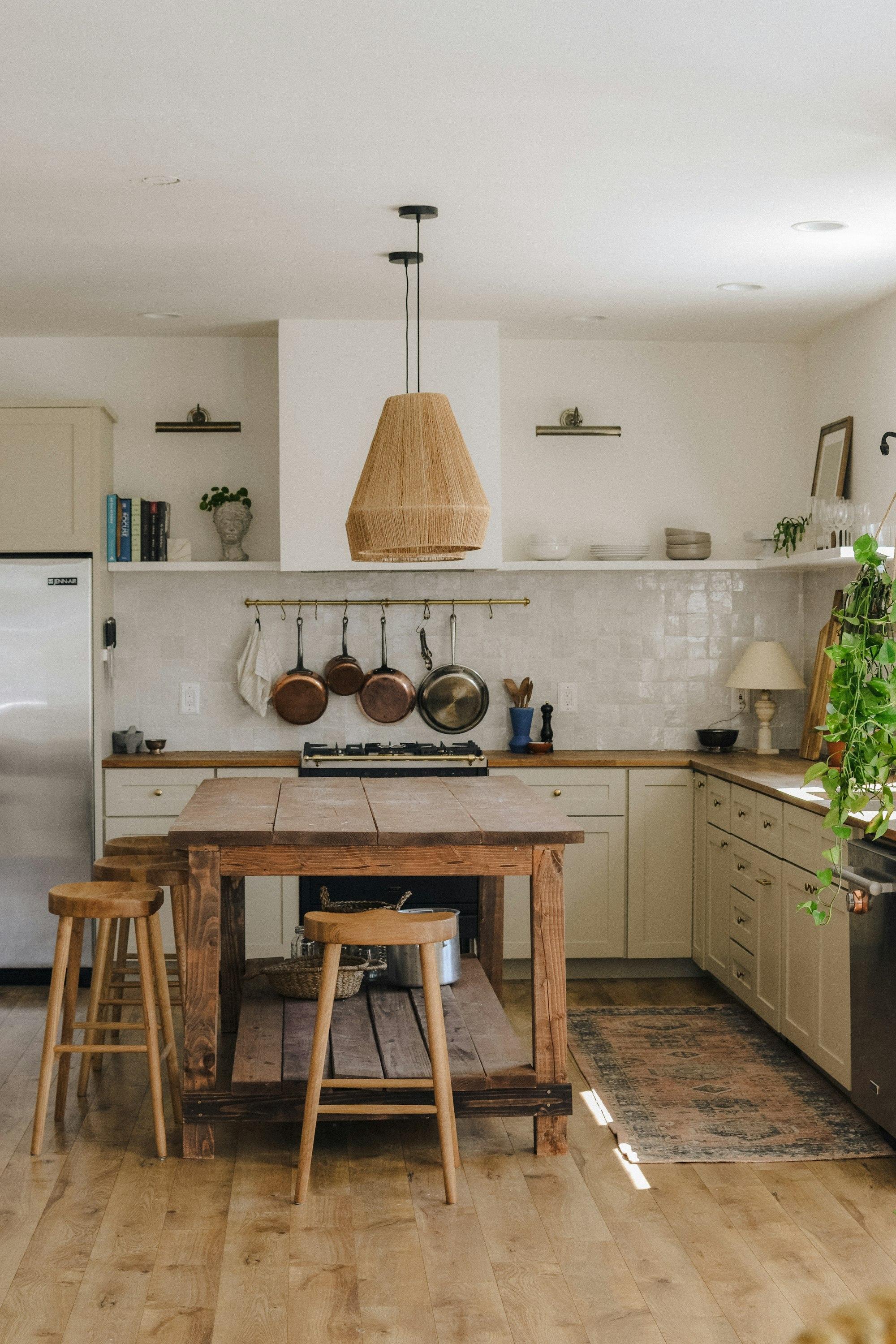What is a Kitchen Island?
Kitchen islands evolve from mere countertops to multifunctional marvels, anchoring modern culinary spaces with style and substance. These freestanding hubs blend prep space, storage, and social zones, proving that in today's kitchens, the heart of the home beats strongest at its center.

Photo by Sosey Interiors
In the realm of modern kitchen design, the kitchen island stands out as a multifunctional centerpiece that enhances both aesthetics and functionality. Whether you’re an avid cook or someone who enjoys hosting gatherings, a kitchen island can transform your culinary space into a hub of activity and creativity. But what exactly is a kitchen island, and why has it become such a staple in contemporary homes? Let’s dive into the details.
The Basics of Kitchen Islands
A kitchen island is essentially a freestanding piece of furniture that is typically placed in the center of the kitchen. It serves various purposes, from additional counter space to extra storage. The design and functionality of kitchen islands can vary widely, making them adaptable to different kitchen layouts and personal preferences. In addition to their practical uses, kitchen islands can also serve as a focal point in the kitchen, drawing the eye and adding character to the space. They can be designed to match the overall theme of the kitchen, whether it be modern, traditional, or eclectic, and can incorporate various design elements such as lighting, seating, and decorative accents. This versatility allows homeowners to express their personal style while enhancing the functionality of their kitchen.
Types of Kitchen Islands
When considering a kitchen island, it’s essential to understand the different types available. Each type offers unique features that cater to various needs:
- Mobile Islands: These are portable and can be moved around the kitchen as needed. They often come with wheels and can serve as extra prep space or a serving area. Mobile islands are particularly useful in smaller kitchens where space is at a premium, allowing homeowners to create additional workspace when necessary and tuck it away when not in use.
- Fixed Islands: These are permanently installed and usually offer more storage options. They can include cabinets, drawers, and even built-in appliances. Fixed islands are ideal for larger kitchens where they can serve as a central hub for cooking and entertaining, providing ample space for food preparation and social interaction.
- Peninsula Islands: A peninsula island is attached to a wall or cabinet on one side, providing a seamless transition between the kitchen and dining area. This type of island can create a natural flow in the kitchen, making it easier to serve meals and interact with guests while cooking.

Materials Used in Kitchen Islands
The materials used for kitchen islands can significantly impact their look and durability. Here are some popular choices:
- Wood: Offers a warm, inviting feel and can be stained or painted to match your kitchen decor. Wood is a classic choice that can bring a sense of warmth and comfort to the kitchen, and it can be customized in various finishes to suit different styles.
- Granite: Known for its durability and elegance, granite countertops are a popular choice for those seeking a high-end look. Granite is not only visually appealing but also resistant to scratches and heat, making it a practical option for busy kitchens.
- Stainless Steel: Ideal for modern kitchens, stainless steel is easy to clean and resistant to heat and stains. This material is often used in professional kitchens due to its hygienic properties and sleek appearance, making it a favorite among culinary enthusiasts.
- Quartz: An engineered stone that combines natural quartz with resins, quartz countertops are non-porous and available in a wide range of colors and patterns. This material offers the beauty of natural stone with added durability and ease of maintenance.
- Concrete: A trendy option for industrial-style kitchens, concrete can be molded into various shapes and finishes. It provides a unique, modern aesthetic and can be customized with pigments and textures to create a one-of-a-kind look.
Benefits of Having a Kitchen Island
Integrating a kitchen island into your space comes with numerous advantages that can enhance your cooking and dining experience. The kitchen island is not just a functional addition; it can also significantly improve the overall flow and usability of the kitchen, making it a more enjoyable space for both cooking and socializing.
Increased Counter Space
One of the most significant benefits of a kitchen island is the additional counter space it provides. This extra surface area is invaluable for meal prep, baking, and even casual dining. It allows multiple people to work in the kitchen simultaneously, making cooking a more collaborative experience. With a kitchen island, you can easily spread out ingredients, tools, and equipment, which can streamline the cooking process and reduce the stress often associated with meal preparation. Furthermore, the island can serve as a designated area for specific tasks, such as chopping vegetables or rolling out dough, helping to keep the kitchen organized and efficient.

Storage Solutions
Kitchen islands often come equipped with cabinets and drawers, offering a perfect solution for storing pots, pans, and utensils. This added storage can help keep your kitchen organized and clutter-free, making it easier to find what you need when you need it. Additionally, some islands can be designed with open shelving, allowing for easy access to frequently used items while also providing an opportunity to display decorative kitchenware or cookbooks. The versatility of storage options available in kitchen islands means that you can customize the space to fit your specific needs, whether you require more room for small appliances, pantry items, or even cookbooks.
Social Hub
A kitchen island can serve as a gathering spot for family and friends. Whether you’re hosting a dinner party or enjoying a casual breakfast, having a central location for people to gather fosters a sense of community and connection. The island can be designed to include seating, allowing guests to sit and chat while you cook, creating a more interactive and engaging atmosphere. This social aspect of kitchen islands is particularly appealing in open-concept homes, where the kitchen flows seamlessly into the living or dining areas. By incorporating bar stools or comfortable seating around the island, you can create a welcoming environment that encourages conversation and interaction, making your kitchen the heart of the home.
Design Considerations for Kitchen Islands
When planning your kitchen island, several design factors should be taken into account to ensure it complements your overall kitchen layout. The design of your kitchen island should not only reflect your personal style but also enhance the functionality of the space, making it a practical and aesthetically pleasing addition to your home.

Size and Proportion
The size of your kitchen island should be proportional to the rest of your kitchen. A large island in a small kitchen can overwhelm the space, while a small island in a large kitchen may feel insignificant. Measure your kitchen carefully to determine the ideal dimensions for your island. Additionally, consider the amount of space needed for movement around the island; ideally, there should be at least 42 to 48 inches of clearance on all sides to allow for easy access and movement. This will ensure that the kitchen remains functional and comfortable, even when multiple people are using the space at the same time.
Style and Aesthetics
Your kitchen island should reflect your personal style and the overall theme of your kitchen. Consider the color, material, and design elements that will harmonize with your existing decor. Whether you prefer a sleek modern look or a rustic farmhouse vibe, there are countless options to choose from. You can also incorporate unique design features such as decorative legs, contrasting colors, or even a different countertop material to create visual interest. Lighting is another important aspect to consider; pendant lights above the island can provide both functional illumination and a stylish focal point, enhancing the overall ambiance of the kitchen.
Functionality Features
Think about what features you want your kitchen island to have. Do you need additional seating? Would built-in appliances like a cooktop or sink be beneficial? Planning these functionalities ahead of time will help you create a more efficient and enjoyable cooking space. For instance, if you frequently entertain guests, you might want to include a wine cooler or a small refrigerator in your island design. Alternatively, if you have children, incorporating a lower countertop section for them to use can make the kitchen a more family-friendly space. Additionally, consider adding electrical outlets to your island for easy access to power for small appliances, charging devices, or even for lighting fixtures.

Kitchen Island Accessories
To further enhance the functionality and style of your kitchen island, consider incorporating various accessories that can elevate its use. Accessories can range from practical items to decorative touches that personalize the space. For example, adding a built-in cutting board or a pull-out trash bin can streamline meal prep and cleanup, while decorative bowls or vases can add a touch of personality and charm. You might also consider installing a pot rack above the island to keep your cookware within easy reach while adding a rustic or industrial flair to the kitchen. Additionally, incorporating a small herb garden or potted plants can bring a touch of nature indoors, providing fresh ingredients for cooking while enhancing the overall aesthetic of the space.
Final Thoughts
A kitchen island is more than just a piece of furniture; it’s a versatile addition that can enhance the functionality and aesthetic appeal of your kitchen. By understanding the different types, benefits, and design considerations, you can make an informed decision that aligns with your lifestyle and preferences. Whether you’re preparing a family meal or entertaining guests, a well-designed kitchen island can elevate your culinary experience and bring your kitchen to life. With careful planning and consideration of your specific needs, a kitchen island can become a cherished feature in your home, providing both practical benefits and a stylish focal point that enhances the overall enjoyment of your kitchen space.
Quick facts
What is the difference between a kitchen island and a peninsula?
A kitchen island is a freestanding counter accessible from all sides, while a peninsula is attached to a wall or another counter on one side, forming a connected layout. Islands allow for more traffic flow, while peninsulas provide additional storage in smaller spaces.
What is the difference between a kitchen island and a bar?
A kitchen island is a multi-functional counter used for prep, storage, and seating, while a bar is typically narrower and designed specifically for seating and serving drinks. Islands are more versatile, offering storage and workspace in addition to seating.
What is the difference between an island and a counter?
An island is a freestanding unit in the kitchen, while a counter is typically built against a wall or cabinetry. Islands offer 360-degree access and may include additional storage or seating, while counters are fixed and generally more limited in function.
Is a kitchen island just cabinets?
A kitchen island typically includes cabinets but also serves as a multi-purpose surface for cooking, dining, and storage. It may feature drawers, shelves, or built-in appliances, making it much more than just cabinets.

Pavan Jadhaw
Software Engineer at Spoken
Pavan is a Fullstack Engineer at Spoken. He's passionate about both software and mechanical engineering. When he's not coding, you’ll find him tinkering with his homeserver, working on his motorcycle, or building custom mechanical keyboards. He’s a fan of minimalistic and functional decor.
Read more